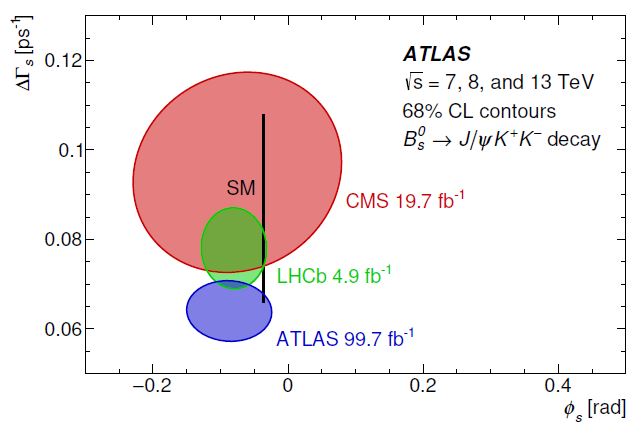The ATLAS Collaboration has released last week the results of a careful analysis of a large dataset of proton-proton collisions acquired during Run 2 of the Large Hadron Collider. This is a measurement of CP violation effects in the system of B hadrons.
Although LHC and ATLAS are things that readers of Science20 may be acquainted with, I realize that the previous 14-word sentence contains already a mention of at least four unknown entities to 99.99% of non specialists, so I suspect I have to open a parenthesis already now.
Very briefly, CP violation is a very peculiar effect that arises in subnuclear reactions involving the weak interaction. All matter particles (quarks and leptons) interact by exchanging particles called the W and Z bosons; in doing so, sometimes they behave in a way that does not respect a symmetry of nature we would naively expect to be respected in every physics process. This is the symmetry that results from considering a physical system and its analogue obtained by interchanging every particle with its antimatter equivalent, and by mirroring their space coordinates. It was discovered in 1964 in a landmark experiment that a very small, but noticeable, fraction of the times the weak interaction does not produce the same results on a system and on its CP-rotated analogue.
Since 1964, physicists have been obsessed with trying to understand more on this topic. And when it was realized that a large amount of CP violation must be envisioned to explain why the universe created all the matter that makes up galaxies around, and not the same amount of antimatter, the topic became even hotter.
ATLAS studies the behaviour of particles called B hadrons, which are made up of a bottom quark and a lighter antiquark. The bottom quark is heavy, and it decays slowly (as compared with other particles), so the hadron is a very good laboratory to study CP violation in detail. The effects to be pinpointed, however, are very small, so they require the study of very large amounts of data and the beating down of tiny systematic uncertainties. It is a sort of gigantic headache, but at the end of the day something new can be learnt.
In the graph below, which summarizes the ATLAS measurement, one sees the plane of two variables that describe these CP violating effects. They have been measured simultaneously, obtaining a confidence region that looks like a grape. Above it stands the LHCb measurement, which looks like an olive. In background is the apricot that describes the CMS result.

It should be clear that the smaller the fruit, the better the measurement: ATLAS and LHCb now constrain the two parameters to lie in a narrower region than did the CMS measurement. However, CMS is on to it too, and soon will release results of the same measurement. The apricot region is its older result, based on a fifth of the data used by ATLAS - hence one does expect it to be roughly speaking 5 times wider on a plane. So it makes sense, as the two experiments have similar measurement capabilities in B physics observables (actually, CMS is a bit better thanks to its stronger magnetic field, but let's not delve in this detail, lest I start getting strings of angry emails from my ATLAS colleagues).
So what is the summary? That CP violation effects have been measured by ATLAS in agreement with previous determinations (as the three fruits are more or less close together) and in agreement with theoretical predictions from the standard model (the black bar). In other words, CP violation does behave as if there were no new physics driving those parameters away from the value the SM expects.
If you need detail of how the measurement has been produced, the article can be downloaded from the arxiv.





Comments